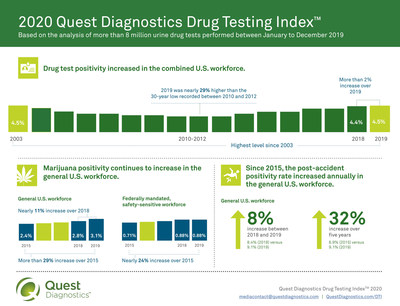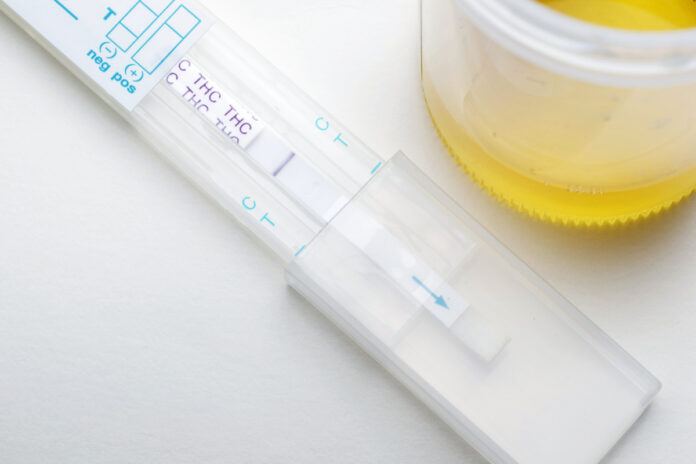SECAUCUS, N.J. – Clinical laboratory Quest Diagnostics released findings from its Quest Diagnostics Drug Testing Index™ today that showed increased rates of workplace drug use in 2019. According to the index, rates have increased to their highest levels since 2003, and were “more than 28 percent higher than the thirty-year low of 3.5 percent recorded between 2010 and 2012.”
Annually serving the clinical health testing needs of one in three adult Americans and 50 percent of the physicians and hospitals in the United States, Quest also is a leading provider of employment lab services, including urine analysis tests for substance use. The company derives its statistics from its database of lab results.
Employment categories that were surveyed for the index included the “general U.S. workforce; federally mandated, safety-sensitive workforce; and combined U.S. workforce, which includes the prior two populations.”
“We believe that the size and scale of this population make it reflective of the American workforce,” a Quest spokesperson told mg. “This data does not include 2020 data. It only includes data up through 2019.”
Cannabis continues to be the most detected federally illegal substance across industries and employment sectors, the data surmised.
In the general U.S. workforce, positive test results for cannabis increased 11 percent in 2019. The Midwest saw a slightly higher rate of cannabis test positivity for 2019, at 14 percent. In the west, data showed double-digit increases in rates for positive cannabis tests year-over-year, up 78 percent since 2015.
“Marijuana continues to be an enduring presence in the U.S. workforce. Changing attitudes toward its use could pose heightened risks especially in safety-sensitive positions and those states exploring legalization,” said Quest Senior Director of Science and Technology Dr. Barry Sample.

PHOTO: Quest Diagnostics
Analysis results also indicated rates of positive substances tests increased in specific regions, including spikes in rates for methamphetamine and cocaine in the Midwest.
Methamphetamine in “the Midwest region experienced year-over-year increases, driven primarily by double-digit increases in the East North Central region during this period,” the findings showed.
“Over the past five years, methamphetamine positivity in the Midwest increased nearly 78 percent (0.09 percent in 2015 versus 0.16 percent in 2019). Illinois (0.03 percent in 2015 versus 0.10 percent in 2019), Indiana (0.14 percent in 2015 versus 0.29 percent in 2019), Michigan (0.014 percent in 2015 versus 0.05 percent in 2019), and Ohio (0.04 percent in 2015 versus 0.11 percent in 2019) increased at least two-fold; while Wisconsin (0.05 percent in 2015 versus 0.09 percent in 2019) nearly doubled,” according to index findings.
Cocaine seems to have also gained in popularity in the Midwest over the last five years, according to the analysis.
“The Midwest was 20 percent less than the national rate [of cocaine test positivity] in 2015, but 3.7 percent above the national rate in 2019, suggesting a surge in positivity in the region last year,” Quest said.
Increased use of stimulant drugs and cannabis contrasted with dropping rates for positive opiates and heroin tests.
Positivity rates for opiates were down 19 percent in 2019, compared to 2018, and had decreased 49 percent over the last five years.
Since peak rates in 2015–16, test positivity for heroin has seen steep decline; down 50 percent from five years ago, with a 33 percent drop in 2019.
Once considered “epidemic,” decreased opiate and heroin use rates may be symptomatic of fundamental changes in the American workplace. The effects of the coronavirus pandemic, which has brought extreme protocol change across the board to almost every industry, have yet to be seen.
An interactive map, created by Quest Diagnostics, shows test rates by three-digit zip code and by substances categories.
If increases in liquor and legal cannabis sales are any indication, “work from home” orders, growing unemployment, and anxiety caused by the pandemic may also have a profound affect on rates of substance use for 2020.
“It is hard for us to speculate,” Quest’s spokesperson said. “What our data does show is that drug misuse is like a game of whack a mole. Once you think you have one substance under control, another can pop up and misuse rates can rise.
“For background, we are planning to do another report on clinical drug testing (drug testing from pain specialists and treatment centers) and COVID-19 later this year,” Quest added.
The Quest Diagnostics Drug Testing Index™ was released today at the Substance Abuse Program Administrators Association (SAPAA) virtual conference. Quest said various experts and industries use the data to inform standards and policy, as well as analyze current substance use trends.
“We have a lot of interest from people in human resource positions who are interested in the safety of their workforce, customers, and community and want to understand trends that may influence their own workplace drug policies, including testing. Insurers are also interested,” the spokesperson described.
“We see interest from policy makers who also want to see substance misuse trends in their respective areas. Substance misuse impacts so much of society, so while this report examines the U.S. workforce, it provides a window to substance misuse in the U.S. [general population],” Quest added.
Quest Diagnostics will discuss the latest data and analysis from the Drug Testing Index in a webinar scheduled for Thursday, September 10, 2020, at 2:00pm EDT. Click here to register.













